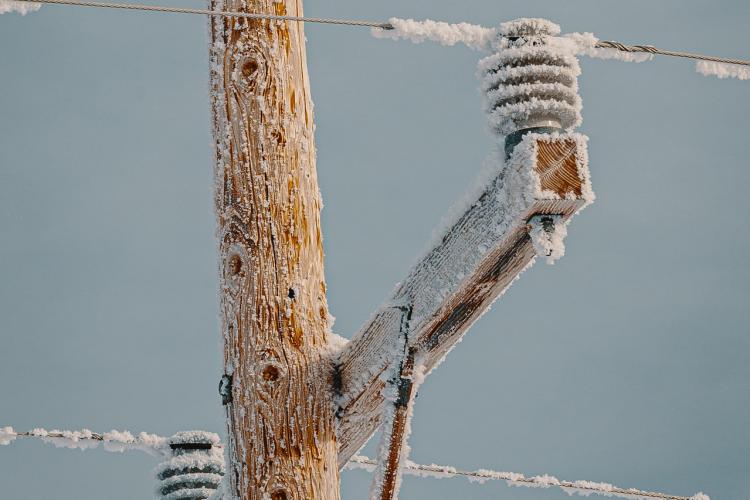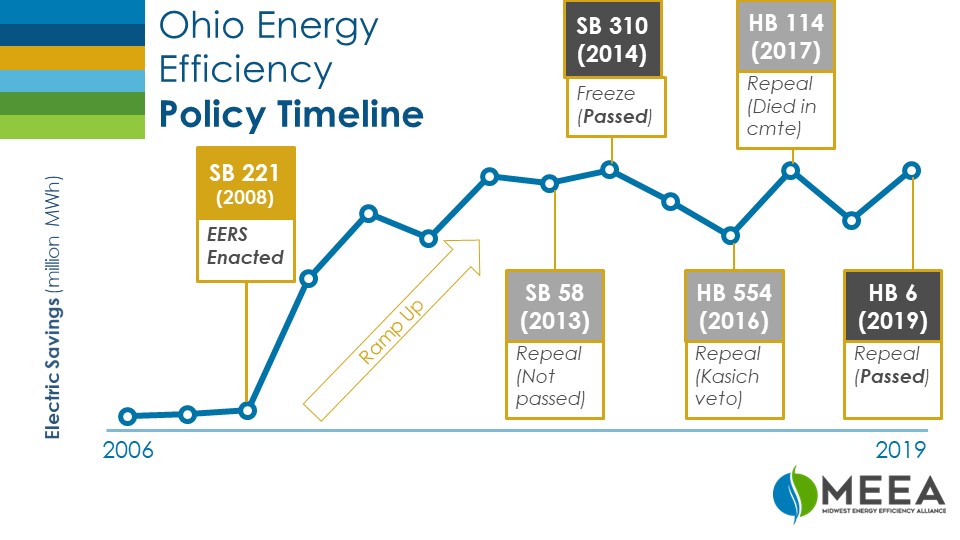
MEEA’s mission to support and advance energy efficiency across the Midwest typically takes shape as promoting supportive policies and the positive impact of EE like new jobs, energy savings, economic impacts and environmental benefits. From time to time, though, the Midwest experiences challenges to energy efficiency. New polices in Ohio have become the greatest barrier to energy efficiency in the Midwest right now, essentially ending all EE programs on December 31, 2020. How did we get here when energy efficiency has continuously been recognized for both economic and environmental benefits?
Legislative Hurdles and Controversy
On the legislative front, HB 6 was enacted in 2019 and ended the energy efficiency resource standard that had been in place since SB 221, which passed with overwhelming bipartisan support (Senate 32:0; House 93:1) in 2008. But, really, since 2013, legislation over energy efficiency has been a slugging match.
Before HB6, there were three other attempts to repeal the EERS, as well as a two-year freeze on the savings targets. It took seven years, but in the end, the repeal narrowly passed.

The passage of HB 6 is now entangled in a federal bribery scandal, leaving the future of energy efficiency policies and programs in question. Now that some of the co-conspirators have entered guilty pleas, the corruption of HB 6 and the contamination of the process leading to its passage is irrefutable. There are strong calls for repeal of HB 6 in its entirety, but no one has a clear plan for whether EE provisions will be reverted to the SB 221 language or if they will be replaced with another more comprehensive bill. At this point, EE programs are ramping down with a scheduled end by December 31, 2020. Ohio’s investor-owned electric utilities are left with an uncertain future for their EE portfolios and for the departments, staff and contractors that are responsible for running their efficiency programs.
Many Other Parties to Please
That is a lot to overcome, but it isn’t just the legislature that has Ohio’s EE future up against the ropes. The Office of Ohio Consumers Counsel (OCC) consistently submits testimony in opposition to aspects of utility energy efficiency plans, especially performance incentive models which they characterize as “little more than easy money for the utility”. The OCC strongly opposes utilities being allowed to earn on their investment in energy efficiency, preferring that utilities only receive cost recovery for energy efficiency program delivery – and don’t seem to be very highly in favor of that, either. Contrary to OCC’s views, utility performance incentives for energy efficiency are a well-established policy mechanism for aligning utility business interests with investments in energy efficiency resources, and are even more important in the move toward performance-based regulation that is happening across the nation. Incentives need to balance against the profitability of selling energy, meet the policy goals of the state, and, of course, should be reviewed regularly to ensure the amount of the incentive is reasonable for achieving its goals, but dismissing them as a money grab by utilities is shortsighted at best.
And if the legislature and the OCC weren’t enough, there is the Public Utilities Commission of Ohio (PUCO). PUCO, and especially its former chairperson Sam Randazzo, who resigned before Thanksgiving, has been another stumbling block for energy efficiency. Prior to his appointment to PUCO, Mr. Randazzo was the lead attorney for the Industrial Energy Users group that opposed renewable energy and energy efficiency (and testified in favor of what became the HB 554 repeal eventually vetoed by Gov. Kasich). In 2020, the commission has sought to block even voluntary energy efficiency plans. In June, Duke Energy Ohio submitted a proposal in Case 20-1013-EL-POR for a scaled-down $21M voluntary EE portfolio to replace their EERS portfolio, which had been approved for $47M budget in 2020 prior to HB 6. The new proposal included, as Duke has been accustomed to, a shared savings incentive where Duke would receive a monetary bonus equivalent to 8% of the net system benefits from cost-effective programs if it met its energy savings targets. It took PUCO only nine days to issue an order striking the shared savings provision. In striking the shared savings, the Commission made their position on future voluntary utility energy efficiency crystal clear – if you want energy efficiency, you should be going somewhere other than your utility to get it:
"Although there may be an important role for the [electrical distribution utilities] to play to enable cost-effective EE and DSM programs, the Commission believes that, in light of HB 6, the future for EE programs in this state will be best served by reliance upon market-based approaches such as those available through PJM and competitive retail electric service providers. …The competitive market can provide cost-effective energy efficiency programs to the customers who choose to participate in such programs. In a competitive market, customers and suppliers are free to work out mutually beneficial cost and benefit sharing arrangements without subjecting other customers to extra risk or cost burdens." (Order of 6/17/20 in 20-1013-EL-POR, emphasis added)
Energy efficiency is shown to reduce financial risk and reduce energy cost burdens for all customers through direct energy bill savings for program participants and through utility system cost savings that benefit all customers. The utility system benefits from EE, according to data from 2017 utility reports, provide an average of $5.30 in system benefits for every $1 invested in EE by Ohio utilities.
Utilities Step Forward
And despite all the political opposition and regulatory hurdles, utilities still want to do energy efficiency! Why? Because they know that their customers want and need it, and it can be an essential part of their resource mix. Duke Energy Ohio has submitted a second voluntary energy efficiency plan, AEP Ohio has included a voluntary energy efficiency plan in their rate case and Dayton Power & Light has come to an agreement with NRDC and other parties to modernize their electric grid, which includes a number of energy efficiency provisions.
|
Utility |
AEP Ohio |
Duke Energy Ohio |
Dayton Power & Light |
|
Case Type |
Rate Case |
EE Portfolio |
Grid Modernization |
|
Case Docket |
|||
|
EE Investment Total |
$36.6 M annual, capped at that amount (2019 EE: $62M) |
$5.99 M estimate, capped at $7 M (2019 EE: $30.2M) |
Includes $450k smart thermostats, $900k LI weatherization (2019 EE: $21M) |
|
Residential Sector EE |
$16.4M |
$5.67 M |
~$1.5M |
|
Low Income segment EE |
$7.0M |
$715k |
$900k |
|
Business Sector |
$13.4M |
$0 (no programs) |
$0 (no direct EE) |
|
Utility performance incentives |
“Administration fee” of 10% of total EE spending if cost-effective at portfolio level |
“Joint benefit recognition mechanism” of 4.5% of avoided T&D costs |
N/A |
|
Other DERs |
EV, DR |
none |
EV, DR |
|
Source link |
|||
|
Other notes |
|
|
|
Even with the legislature, the state consumer advocate and the commission all aligned against it, these proposals show that the utilities in Ohio still recognize the value of energy efficiency for their resource mix, the viability of the electric grid, the bill savings and the health, safety and resiliency of their customers. Even without a concrete policy framework and in the face of hostility, these three utilities put forth plans of varying approaches for energy efficiency in their territories. They might not all work. They certainly won’t reach all cost-effective energy savings. The data will be more complicated to understand. But these proposals will help to maintain the energy efficiency workforce in Ohio so when the uncertainty is over, there will already be a foundation to build upon.
It’s an uphill struggle for EE in Ohio, and stakeholders from the EE industry should come together in support of these utility efforts to keep EE alive in Ohio. There are lessons from around the Midwest of legislatures that support energy efficiency, like Michigan; of consumer advocates that work with stakeholders in statewide EE collaboratives, like Illinois; and of commissions that support voluntary energy efficiency with clear rules and requirements and ongoing engagement, like Indiana and Missouri. Ohio has a strong network of individuals, organizations and utilities demonstrating how policy can work to move energy efficiency forward across the state. It’s time for those standing in the way to work together with Ohio utilities to provide Ohioans a healthy and affordable energy option.